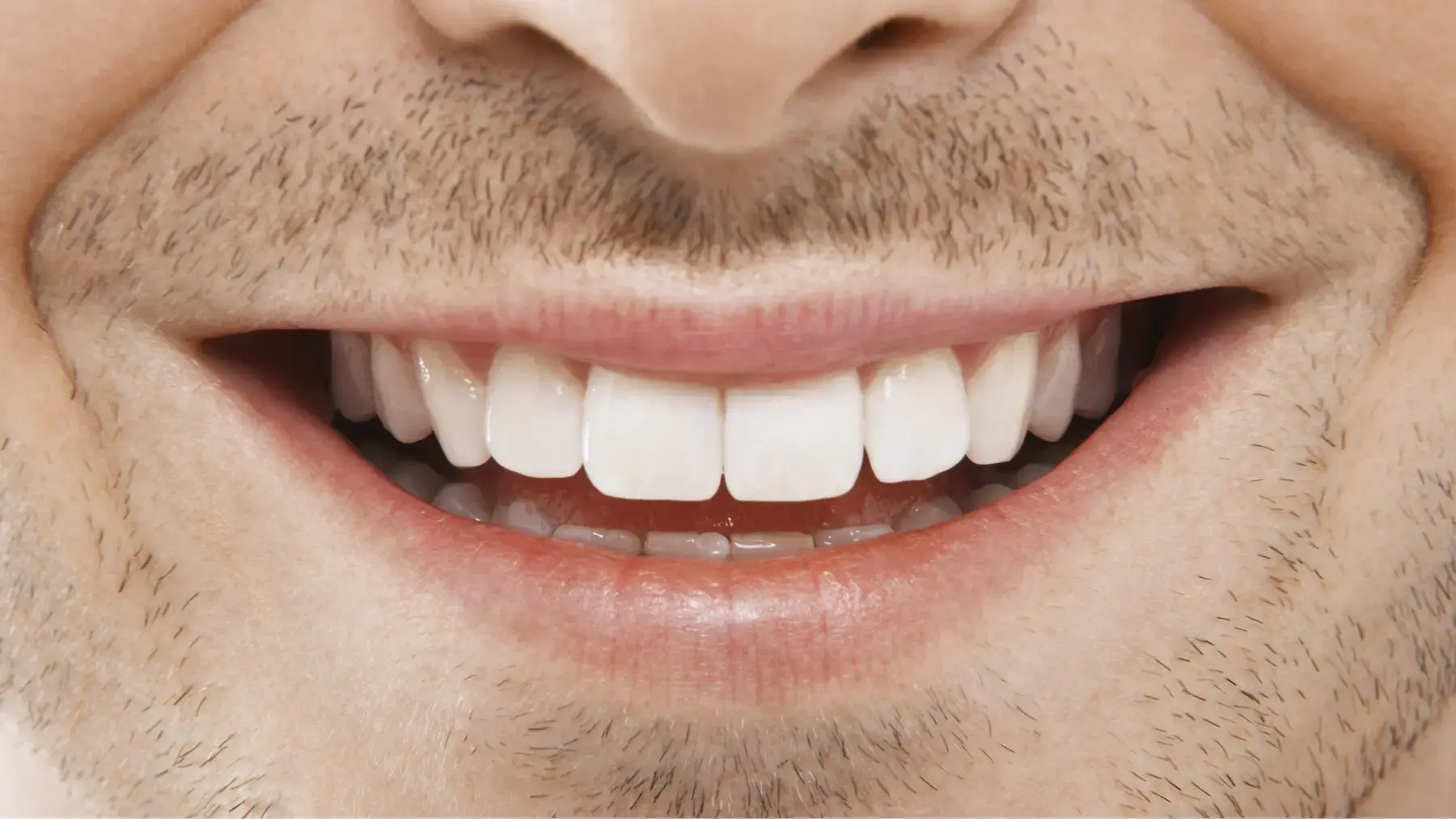Tired of the discomfort caused by tooth sensitivity when eating, drinking, or even speaking or breathing? This article is for you. It explores common causes of tooth sensitivity, such as brushing too hard, gum recession, plaque buildup, and frequent consumption of sugary or acidic foods.1 More importantly, it provides practical solutions to manage and relieve this sensitivity, from improving oral hygiene habits to using specialized products and seeking professional dental treatments. By the end of this article, you’ll understand how to better protect your teeth and achieve lasting relief from sensitivity.
What is Tooth Sensitivity?
Tooth sensitivity is an oral condition known as “dentin hypersensitivity” and can be caused by receding gums and/or damaged enamel exposing the softer, inner part of the tooth called ‘dentin.’ On the surface of the dentin, there are microscopic openings called dentin tubules which lead to the tooth's nerves. In a healthy mouth, these tubules are covered by enamel or cementum (the soft covering of the tooth root. When dentin becomes exposed, food or drinks that may never have hurt your teeth before can begin to cause sharp pain. This happens because foods like hot coffee or even ice water directly stimulate the nerve in your tooth through the dentin tubules, resulting in a sharp shooting pain known as dentin hypersensitivity. Only a dentist can confirm if you have dentin hypersensitivity, but in the meantime, you can minimize symptoms and prevent further damage by making simple changes to your dietary habits and daily oral health care routine.1–3
Common Causes of Sensitive Teeth
Tooth sensitivity can stem from various causes, many of which are linked to everyday habits and underlying dental issues. Here is a comprehensive list of the most common of these causes:2
Aggressive Brushing
Lacking Routine Oral care
Gum Recession
Sugary & Acidic Diet
Teeth Whitening
Teeth Grinding
A detailed explanation of how each of these causes is implicated in sensitivity and more information on the topic can be found in our other article here.
How to Reduce Teeth Sensitivity
So, what helps soothe sensitive teeth? Simple changes to your daily oral healthcare habits can provide pain relief. Follow these tips to ease tooth pain from sensitivity.
Brush With Softer Bristles
As previously mentioned, gum recession is a common cause of sensitivity, and brushing too hard can make matters worse., This is why it is highly recommended to,1. brush gently following the technique your dentist recommended, and use a soft-bristled toothbrush. Brushing with softer bristles that are gentle on both your gums and enamel is important because hard or medium bristles can be too abrasive and can worsen sensitivity. By switching to a soft-bristled brush and brushing gently, you can help protect your teeth from further sensitivity and maintain optimal oral health (as recommended by the ADA).3–5
(mouth)Guard Your Teeth Overnight
If you are grinding your teeth involuntarily while you sleep, a condition known as bruxism, this grinding could cause abrasion of your teeth.6 Waking up with a sore jaw is a common sign of sleep grinding, though it can also occur during the day.7 In these cases, it is recommended that you consult your dentist, who can suggest a custom-made dental mouth guard to protect your teeth at night.8,9
How to Prevent Tooth Sensitivity
Maintain a good oral hygiene routine
Keeping in mind that dentine hypersensitivity is almost exclusively associated with exposed dentine due to tooth wear or gingival recession, it is no secret that one of the main ways to prevent tooth sensitivity is maintaining good oral hygiene, by brushing twice daily with a soft-bristled toothbrush and fluoride toothpaste and flossing daily to remove plaque.1,3
Avoid Sugary & Acidic Foods
Another concept to be kept in mind is that acidic foods and drinks can make your enamel softer which in turn leads to tooth wear and potentially the exposure of the famous dentinal tubules that lead to the nerves of your tooth and cause pain.1 Associated with abrasion which is the loss of tooth structure due to tooth to tooth contact, acid further accelerates the process of tooth structure loss causing sensitivity.1 As for sugary foods and drinks, they can also stimulate these nerves in your teeth causing sensitivity when ingested. As a result, it’s recommended to avoid sugary foods and drinks to prevent sensitivity.10
Follow The Protocols When Whitening Your Teeth
Everyone loves having a pearly white smile, but whitening procedures can sometimes result in temporary tooth sensitivity.11 Certain products on the market have high concentrations of whitening agents (such as hydrogen peroxide or carbamide peroxide), and their use can lead to increased sensitivity. Leaving the product on for longer than recommended can also cause issues.11 That’s why following your dentist’s recommendations to prevent bleaching-related sensitivity is important.12,13
Protect your Sensitive Teeth with Listerine® Sensitive Teeth Alcohol Free Mouthwash
To help shield and protect sensitive areas of your teeth where tooth structure, including enamel and cementum has been lost,, you can use LISTERINE® Clinical Solutions Sensitive Teeth with CRYSTAL BLOCK™ Technology, an alcohol-free formula. With continual use of LISTERINE® Clinical Solutions Sensitive Teeth, you can get 24-hour relief. LISTERINE® Clinical Solutions Sensitive Teeth starts working immediately to eliminate tooth sensitivity by blocking exposed dentin tubules. Potassium oxalate binds to calcium ions in saliva to form calcium oxalate crystals which are then deposited on the dentin, clustering inside the dentin tubules and blocking the pathway to the nerves inside your teeth. After just 6 rinses with LISTERINE® Clinical Solutions Sensitive Teeth, this mouthwash formula with CRYSTAL BLOCK™ Technology aids in blocking 97% of the exposed dentin tubules.**
** In laboratory studies.
Consult Your Dentist for Tooth Sensitivity Treatments
If you experience lasting pain, you should immediately consult a dentist for proper tooth sensitivity treatment options. Not only will your dentist diagnose the issue, but they can also advise you on treatments to help alleviate the pain. It's not just in advanced cases that a dentist can be helpful; even in the early stages of pain, your dentist can provide solutions such as fluoride desensitizing treatments.1 Lastly, seeing your dentist regularly can help prevent tooth sensitivity by diagnosing and addressing the root causes of sensitivity early.1
References
Gillam, D.; Chesters, R.; Attrill, D.; Brunton, P.; Slater, M.; Strand, P.; Whelton, H.; Bartlett, D. Dentine Hypersensitivity--Guidelines for the Management of a Common Oral Health Problem. Dent Update 2013, 40 (7), 514–516, 518–520, 523–524. https://doi.org/10.12968/denu.2013.40.7.514.
Cattoni, F.; Ferrante, L.; Mandile, S.; Tetè, G.; Polizzi, E. M.; Gastaldi, G. Comparison of Lasers and Desensitizing Agents in Dentinal Hypersensitivity Therapy. Dentistry Journal 2023, 11 (3), 63. https://doi.org/10.3390/dj11030063.
Drisko, C. Oral Hygiene and Periodontal Considerations in Preventing and Managing Dentine Hypersensitivity. International Dental Journal 2007, 57 (S6), 399–410. https://doi.org/10.1111/j.1875-595X.2007.tb00167.x.
Pereira, T. P.; Vieira, T. A. F.; Dos Santos, W.; Bezerra, S. J. C.; Sobral, M. Â. P.; Scaramucci, T. Influence of Different Ultra-Soft Toothbrushes on Erosive Tooth Wear. J Dent 2023, 132, 104502. https://doi.org/10.1016/j.jdent.2023.104502.
Toothbrushes. https://www.mouthhealthy.org/all-topics-a-z/toothbrushes (accessed 2025-02-03).
Pavone, B. W. Bruxism and Its Effect on the Natural Teeth. The Journal of Prosthetic Dentistry 1985, 53 (5), 692–696. https://doi.org/10.1016/0022-3913(85)90026-5.
Svensson, P.; Jadidi, F.; Arima, T.; Baad-Hansen, L.; Sessle, B. J. Relationships between Craniofacial Pain and Bruxism. Journal of Oral Rehabilitation 2008, 35 (7), 524–547. https://doi.org/10.1111/j.1365-2842.2008.01852.x.
THE ROLE OF DENTAL GUARDS IN MANAGING DENTAL PARAFUNCTION: A DETAILED ANALYSIS – Romanian Journal of Oral Rehabilitation. https://rjor.ro/the-role-of-dental-guards-in-managing-dental-parafunction-a-detailed-analysis/ (accessed 2024-12-19).
Singh, P. K.; Alvi, H. A.; Singh, B. P.; Singh, R. D.; Kant, S.; Jurel, S.; Singh, K.; Arya, D.; Dubey, A. Evaluation of Various Treatment Modalities in Sleep Bruxism. The Journal of Prosthetic Dentistry 2015, 114 (3), 426–431. https://doi.org/10.1016/j.prosdent.2015.02.025.
West, N. X.; Lussi, A.; Seong, J.; Hellwig, E. Dentin Hypersensitivity: Pain Mechanisms and Aetiology of Exposed Cervical Dentin. Clin Oral Invest 2013, 17 (1), 9–19. https://doi.org/10.1007/s00784-012-0887-x.
Carey, C. M. Tooth Whitening: What We Now Know. Journal of Evidence Based Dental Practice 2014, 14, 70–76. https://doi.org/10.1016/j.jebdp.2014.02.006.
Pohjola, R. M.; Browning, W. D.; Hackman, S. T.; Myers, M. L.; Downey, M. C. Sensitivity and Tooth Whitening Agents. Journal of Esthetic and Restorative Dentistry 2002, 14 (2), 85–91. https://doi.org/10.1111/j.1708-8240.2002.tb00156.x.
Piknjač, A.; Soldo, M.; Illeš, D.; Knezović Zlatarić, D. Patients’ Assessments of Tooth Sensitivity Increase One Day Following Different Whitening Treatments. Acta Stomatol Croat 2021, 55 (3), 280–290. https://doi.org/10.15644/asc55/3/5.




